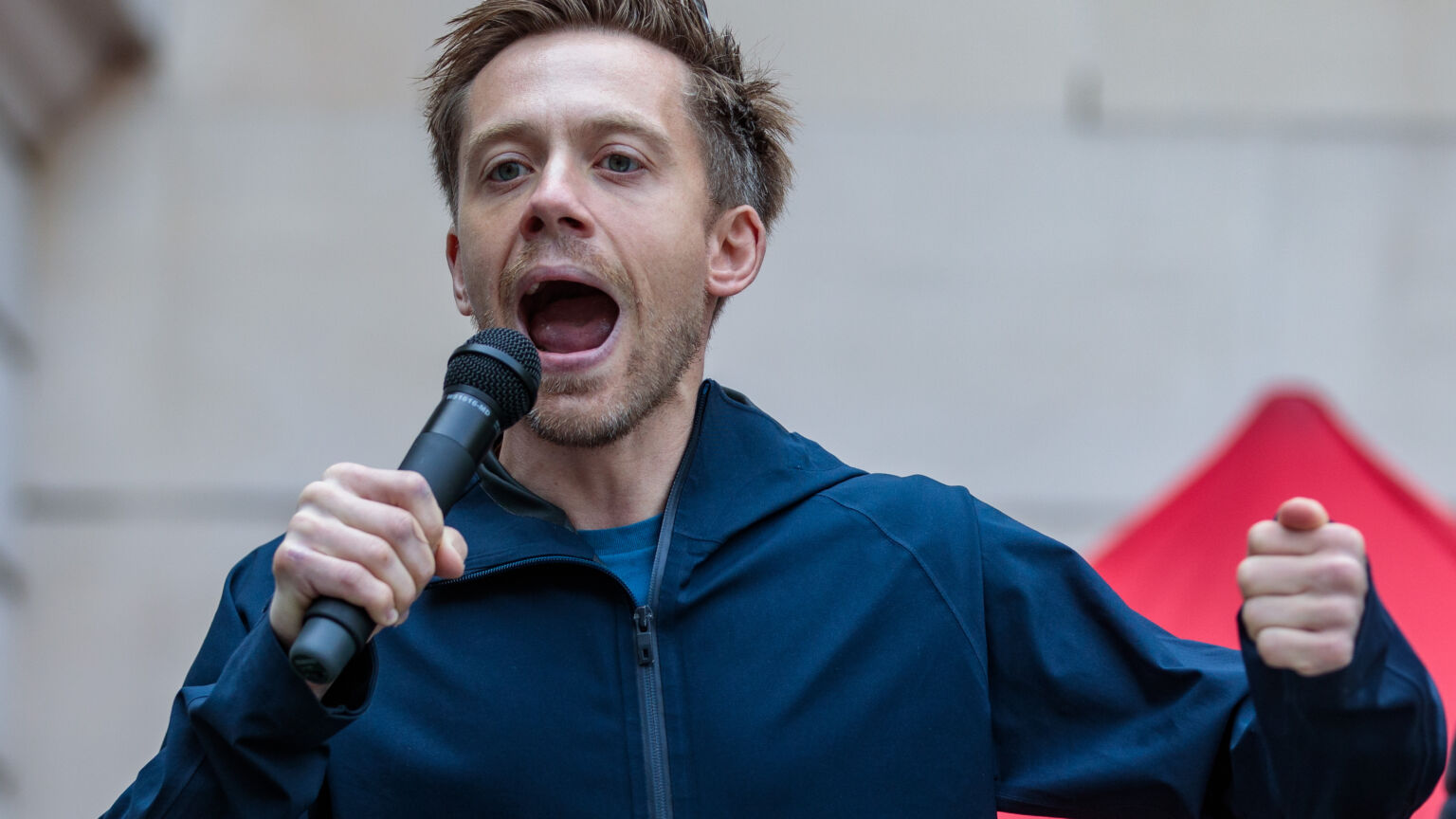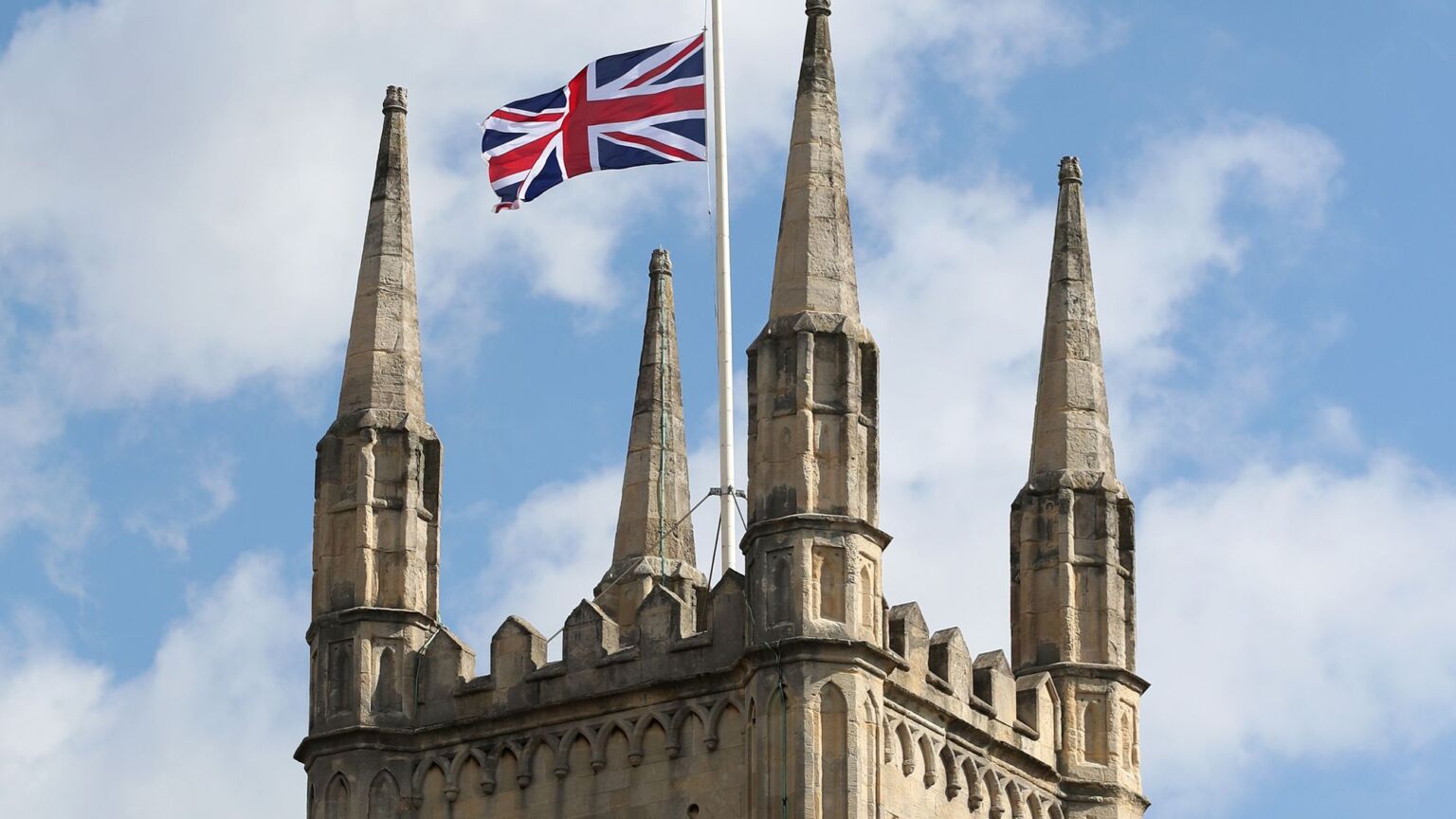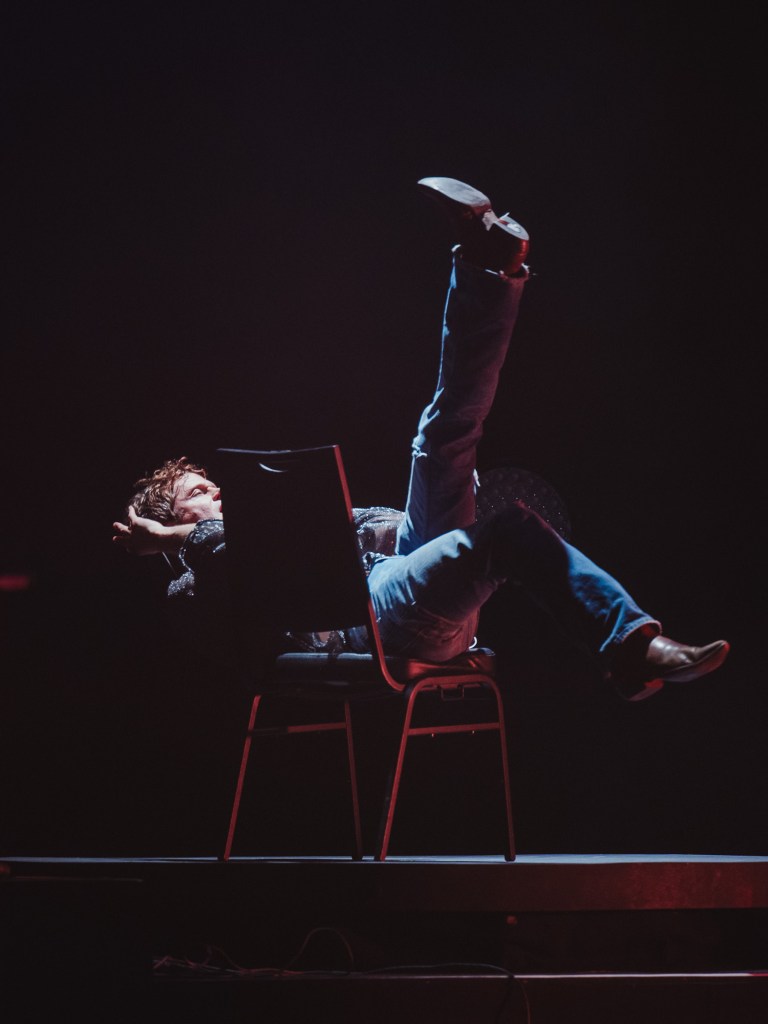
Art duo Gilbert and George object to the term ‘gentrification’ to describe the ongoing overhaul to the east London neighbourhood that has been their home for almost 60 years. ‘We think it’s classist and sexist, because you’d never say ladyfication. Or Jewification. Or blackification. Or Bangladeshification’, they once informed the Guardian, with their signature prankishness. ‘They’ve only got it in for white people. It’s punishing the honkies.’
The artists moved to Spitalfields, Tower Hamlets in 1968 and quickly occupied dilapidated basement rooms in a former Huguenot house on Fournier Street. More than half a century later, they remain at the same address, having bought the entire house in the 1970s. From here they adhere to the routine of work, walking and eating out, established early on, even though they are now in their 80s.
At one end of the road, ‘gentrification’ brings a Gotham City skyline to Liverpool Street; at the other, what survives from an earlier overhaul of the neighbourhood that began when Gilbert and George arrived in these parts, when ‘Bangladeshification’ succeeded the ‘Jewification’ that altered the neighbourhood from the end of the 19th century. The Brick Lane Jamme Masjid at one corner of Fournier Street was a synagogue from 1897, and originally a Huguenot chapel. Nearby Christ Church, the imposing 18th-century Anglican church designed by Nicholas Hawksmoor, is a relic from an altogether different age. A recent development in the neighbourhood that brings the past, the present and the future together in one building is the Gilbert and George Centre, which opened in 2023 and occupies a former brewery. ‘All the museums now are woke’, they stated in 2021, which is one of the reasons they are funding a venture that will survive when they’ve gone – as a testament to their history on these streets and the works the locale inspired.
The art world continues to suffer from the condition of ‘woke’. As a consequence, the institutions also suffer from low attendance figures and diminishing revenue. Despite being elderly white men, Gilbert and George have not been sidelined, censored or silenced. From October this year until June 2026, London’s Hayward Gallery will exhibit a large selection of their 21st-century pictures.
The scale of the exhibition is a testament to their persistence and relevance (although it’s dwarfed by their major retrospective at Tate Modern in 2007). A recent Times Literary Supplement review of James Birch’s Gilbert and George and the Communists (2025), in which the author relays his experience of accompanying the artists to Russia and China in the 1990s, suggests Gilbert and George have been contemporary ‘for longer than almost anyone else’. It was at the Hayward Gallery in 1972 that they came to prominence, as part of The New Art show. They were as at odds with those who exhibited alongside them as they were with their fellow students at St Martin’s School of Art, where they met in 1967. They were opposed to the conceptualism that was in vogue. They wore suits. They insisted on good manners. ‘Two clean boys’, according to Gilbert, ‘with funny ideas behind the scenes’. They were, and remain, patriots, royalists and conservatives, while being pro-sexual-freedom and anti-religion. They often dismiss other artists as meaningless, and accuse them of not asking questions. ‘We are quite disillusioned with that kind of art ourselves. We want an art that is in your face’, Gilbert said in 2017. ‘We are confrontational.’ As other artists classified themselves as radicals railing against the establishment (which, incidentally, often funded them), Gilbert and George produced work that disturbed those on both the left and the right. ‘We want our art to bring out the bigot from inside the liberal and conversely bring out the liberal from inside the bigot’, they said in 2023.
The poster for the 1972 Hayward Gallery show features them in their staple tweedy suits, emerging from or disappearing into bushy foliage. It could almost be a double LP cover for the time. The work exhibited (‘The Shrubberies’) was a development on The General Jungle pictures that preceded it: floor-to-ceiling charcoal drawings in which the two men are solitary figures in nature’s wilderness. They described themselves as country boys, with George (Passmore) hailing from Devon, England and Gilbert (Proesch) a native of the mountainous Dolomites in northern Italy. It wasn’t until they embraced photography that they became urban artists, simultaneously creating the grid format to frame their montages that they use today. Their photographic works from the early 1970s capture them drunk at a Bethnal Green wine bar, or within the sterility of their home with its panelled walls and bare floorboards. The most enduring pictures focus on the everyday subjects that other artists discarded, whether it was the working-class locals, graffiti, headlines on newspaper stands and sex cards in phone boxes.
Collectively, their work provides a unique social document covering the changing nature of the East End – and London – that’s been described as subversive, shocking, tragic and comic. A common thread running through the work is those ancient East End streets the two young men navigated as odd interlopers, and now wander like disembodied figures or ghosts, forever indifferent to the changes they’ve been privy to for more than half a century.
When they moved there in 1968, swinging London was a rumour rather than a reality on these streets, but change was imminent. That other infamous local double act, the Kray twins, were sentenced to lengthy prison terms that year. A budding entrepreneur established the short-lived retail unit, ‘Cockneyland’, to transform the remnants of the urban, white working-class caricature associated with the area into a tourist attraction, with merchandise to match. The BBC returned East End natives, actress Georgia Brown and composer Lionel Bart, to their Jewish East End roots, in the midst of a modern diaspora, to address the question: ‘Who Are the Cockneys Now?’ It was also the year of Enoch Powell’s infamous ‘Rivers of Blood’ speech.
The past was being demolished, but the future appeared to have failed before it got off the ground. The new east London tower block, Ronan Point, a glimpse of the housing of tomorrow, was blown apart by a gas explosion, which killed four residents. Still, the slum tenements survived from the Victorian era, which journalists and social anthropologists had reported on a century earlier, as authors Arthur Morrison and Jack London transposed their East End experience into novels that were heavy on Grand Guignol-style horror and gore, and light on the humanity of the inhabitants. These transient missionaries exposed the horrors; the local press overlooked them. As London wrote in The People of the Abyss (1903): ‘Late last night I walked along Commercial Street from Spitalfields to Whitechapel… And as I walked I smiled at the East End papers, which, filled with civic pride, boastfully proclaim that there is nothing the matter with the East End as a living place for men and women.’ A similar approach is relevant now, when the mainstream media report on the East End, and London generally, by rolling out the official mantra on multiculturalism. Purposely ignoring divisions that debunk the myth and worsen the reality, the more this defunct fantasy is perpetuated.
Shortly after their arrival in the East End in 1968, Gilbert and George embarked on their ‘Art For All’ vision. Perched on a table beneath a nearby railway viaduct surrounded by bomb sites, they performed ‘Underneath the Arches’, the song associated with local boy-made-good Bud Flanagan, who died that year. Bemused locals gathered like the small congregational groups that once surrounded preachers, salvationists and socialist orators on those streets, rather than two men in suits with painted silver faces. ‘The Singing Sculpture’ (1969), as the piece was entitled, propelled them into galleries in Europe and New York, making them the exhibit, a move that is central to their art. Recalling those early years, Gilbert has said: ‘This whole idea of making ourselves the centre of our art and trying to leave something behind, that was totally unusual.’
Despite the localised detail, the work has been shown in galleries throughout the globe, throughout the years, with Gilbert and George maintaining they are not indigenously London artists. The London natives among us, familiar with similar streets, along with many of those the couple have walked along, tend to disagree. The territory they document is unique because no other working-class area in east London, or south-east London, had been subjected to the successive waves of immigration, until now. The streets and buildings the artists photographed convey a mood and evoke memories for those whose history and ancestry is in these streets.
Arguably, Gilbert and George are in keeping with that tradition of writers and sociologists from the 19th century who delved into these netherworlds, except they only moved to the East End because they were ‘poor’ and remained because it was ‘romantic’. The duo observed, but rarely commented on, all they were witness to. This annoyed some critics, who accused them of exploitation and voyeurism – and, all too predictably, ‘racism’ and ‘fascism’.
If it’s true that they’ve been contemporary longer than anyone else, it’s perhaps because they held their nerve, and were always ahead of the curve. The culture has caught up with them, and as a consequence they are now attributed national-treasure status. A position that diminishes the impact of the work in the context of the time it was produced.
Some of us arrived at Gilbert and George through pop and fashion, rather than art. We were aware of these men in suits when, back in 1977, they were figures sometimes found at London punk clubs, gay clubs and the Blitz in Holborn, which soon attracted the theatrical new romantic crowd. The couple’s sartorial style pulled us towards art galleries; their work, which moved from monochrome to the vivid palette associated with Mondrian, Disney and stained glass, kept us returning. According to George: ‘When most people see our pictures they think the images are talking about themselves rather than us. They see their own lives in relation to the pictures.’ It was The Dirty Words Pictures (1977) that drew some of us in, with content and titles taken from local graffiti (‘Paki’, ‘Queer’, ‘Cunt’, ‘Scum’). Some of these insults were levelled at Gilbert and George by local natives when they first became Spitalfields residents (‘faggots’, ‘poofs’). Those of us who experienced similar during our formative years remember the culprits as boys we didn’t want to be. Boys we sometimes wanted, but never wanted to become.
Similar figures featured in works of Gilbert and George, who were criticised for essentially elevating these working-class subjects above their social class. Using a line-up of local young men in ‘Patriots’ (1980) led to charges of ‘racism’ from critics who failed to notice a Bangladeshi boy among them. The young white men in ‘Four Knights’ (1980) caused consternation. One particular gallery, exhibiting the picture years later, stated: ‘Its meaning is ambiguous, perhaps contrasting the alienation of modern youth with the heroes of medieval chivalry, but the reason for Gilbert and George’s interest is unclear, should these young men be admired or feared?’
Before national-treasure status beckoned and blurred the controversies of earlier years, those who embrace a cosmetic radicalism and controversy in the arts found Gilbert and George impossible to categorise. They were an antidote to the leftist outlook artists conformed to; they resisted being courted by the gay lobby. It was only when they targeted religion, and particularly Christianity, that liberal critics could truly let out a sigh of relief and comfortably shower them with praise. But perhaps Gilbert and George’s take on Christianity isn’t as simplistic as the views of the critics who welcomed it. Between the back yard of their house on Fournier Street and the studio it connects to, where they produce their pictures, there is an ancient stone fountain inscribed with a quote attributed to Jesus in the book of John: ‘If any man thirst, let him come unto me and drink.’
In 2006, The Sonofagod Pictures were accompanied by the question, ‘Is Jesus heterosexual?’. No such statement was issued about the Prophet Muhammad in the series, but Gilbert and George have perhaps gone further than most successful artists when using imagery associated with Islam, which has become so prevalent in the East End and beyond. ‘Islam’ from London Pictures (2011) features the disembodied faces of Gilbert and George beneath authentic newspaper headlines (‘London “Islam” school teaches hate’; ‘Islam “insult” Briton faces lash’).
‘Maybe 10 years ago, all non-Muslim houses in the street were kicked in’, George revealed in a 2017 interview. ‘They used to say, “Fuck off out of this, this is a holy place”.’ This is part of a wider local trend that picked up momentum in the aftermath of the 9/11 attacks, and according to Gilbert and George, when the imams moved into the East End. There were, and remain, attempts to make the neighbourhood a ‘no gay’ zone, with even a ‘Muslim patrol’ confronting gay men, anyone with alcohol, and women in vest tops and short skirts. In 2011, a 21-year-old artist friend of theirs, and another St Martin’s alumni, was set upon by a gang in a ‘homophobic’ attack that left him paralysed and confined to a wheelchair. The LGBT activist, Peter Tatchell, organised a march to address this issue. He wrote: ‘Earlier this year, stickers were plastered around East London declaring it a “Gay Free Zone”, warning that Allah’s punishment for homosexuality is severe.’
Art critic Jonathan Jones, who has written at length on Gilbert and George throughout the latter part of their career, maintains that their most truthful works are made when they are drawn to darker subjects. The Dirty Words Pictures were offensive and controversial to those on the left, while The Fundamental Pictures (1996), with titles such as ‘Spunk’ and ‘Piss’, were obscene to the more conservative art aficionado. The Naked Shit Pictures (1995) were comic to some, because two middle-aged male artists, famously forever in tweed suits, were suddenly naked with flaccid penises, parted arses, testicles heading towards the knees, and white y-fronts at ankle level.
But it’s perhaps the later works, particularly London Pictures (2011) and similar, that provide the most truthful account of what London has become – the modern Grand Guignol that has echoes as dark as that discovered by social anthropologists in the Victorian past. It is these that will be remembered as prescient, troubling and tragic.
Michael Collins is a writer, journalist and broadcaster. He is the author of The Likes Of Us: A Biography of the White Working Class.
#Gilbert #George #honest #chroniclers #London




